|
BACKGROUND
SEA
SEA, THE
RIVER
RIVER
RED SEA
RED SEA, PASSAGE OF
EXODUS
RED SEA
I. The Bitter Lakes region
II. The Gulfs of Suez and Aqabah
JORDAN
I. Archaeological sites
II. Topographical features
The
full background to this teaching is available online at this link
FULL BACKGROUND HERE (For serious students)
|
Online links to scriptures (New International Version [NIV] unless otherwise stated) are shown in blue
| FROM JORDAN TO JORDAN |
|
 Between the times the Jordan was supernaturally divided, firstly with Joshua, then by Elijah and Elisha, the glory days of Israel had come and gone. The majority of their promised inheritance had been claimed, and gradually lost. Claimed through obedience, particularly during the days of Joshua and King David, and lost during times of general disobedience by the kings following Solomon.
However, God did not desert His people, but communicated mainly through His prophets, for the kings and priests slid back into the ways of the world. Yes, God always has a ‘Plan B’ when His people, us included, let Him down.
Remarkably, God repeated the pattern He established with Moses and Joshua, with Elijah and Elisha. As we saw earlier, Moses was a type of Jesus and Joshua, one of us.
Under Moses and Joshua we saw the physical inheritance of the Israelites take place, while the role of Elijah and Elisha was that of restoring a spiritual inheritance.
Once again, in the lives of these two great, yet very human, prophets, we have a picture of Jesus in Elijah, the Church, and ourselves, in Elisha. For Jesus permeates all Scripture, not just the New Testament.
|
| ELIJAH: A picture of Jesus. |
|
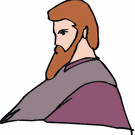 1. Displayed God’s Power during the time of the worst excesses of any of the kings of the divided kingdom, the reign in Israel of King Ahab
and his notorious wife Jezebel.
|
|
|
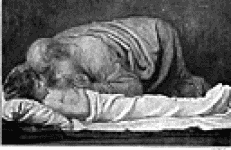 2. Did the Greater Miracles of the two, but only half the number.
|
|
|
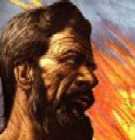 3. Is Held in honour, as is Moses, as is Jesus.
|
|
|
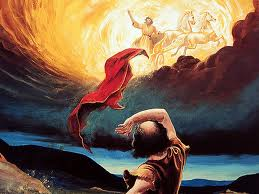 4. Ascended to Heaven, as did Jesus.
|
|
|
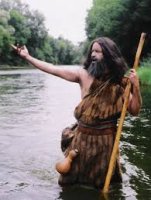 5. Was to Return, as is Jesus.
|
| ELISHA: A picture of the Church. |
|
 1. Displayed God’s Grace to Individuals, as we are meant to.
|
|
|
 2. Did Twice as Many Miracles, but not as spectacular, as is the case with us when compared to Jesus.
|
|
|
 3. Possessed the Land Spiritually, as did Joshua in the physical, and as we are to do.
|
|
|
 4. He Died – as we do.
|
|
|
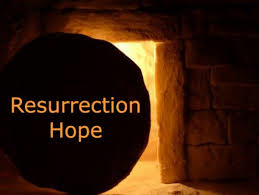 5. Has the Hope of Future Resurrection, as do we.
So let’s take a look and see what we can learn from these two chosen prophets of God.
|
| 3. DIVIDING THE JORDAN AGAIN |
|
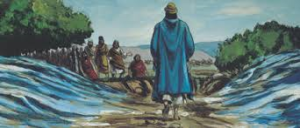 These twin dividings of the River Jordan are considerably less well known than the two previous occasions. Probably because only two people were involved and but 50 watching!
2 Kings 2:6-14
|
| TWO TYPES OF INHERITANCE |
|
 As on the previous occasion, the parting of the Jordan’s waters signified to the people a change in leadership. Firstly, from Moses to Joshua, then from Elijah to Elisha. Interestingly, they represented the two different types of inheritance, physical (of leaders of Israel) and spiritual (of the prophets).
|
| 1. PHYSICAL INHERITANCE: OLD COVENANT: Moses to Joshua |
|
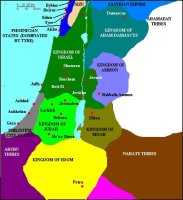 Crossing the Jordan under Joshua was the first step in claiming the Israelites physical inheritance in Canaan. The Old Covenant is built around physical prosperity, so naturally, the provision of a country for the people to live in formed the central, essential part of the promise. As is still the case today for us as individuals, home ownership gives a security of tenure that renting doesn’t. The Israelites were thrilled to be taking the first steps into the land they had dreamed of inheriting for so long. This expansion of territory under Joshua and David explains why the people held both in such high regard. For they were the beneficiaries!
|
| 2. SPIRITUAL INHERITANCE: NEW COVENANT: Elijah to Elisha |
|
 This second crossing of the Jordan occurred at a time of great apostasy amongst the people, a time when they were following worldly rather than godly ways. So instead of all the people witnessing the crossings, only a select group of 50 prophets, those still following in the Lord’s ways, were allowed to witness the events.
This spiritual inheritance though, was not simply given to Elisha but had to by claimed, or possessed, by crossing the Jordan. Here however, the return crossing was also made, symbolically taking the spiritual inheritance back to the physical one on the side of the river already claimed by the people under Joshua.
This is a beautiful picture of the New Testament, spiritual inheritance to come, some 850 years later. Here the emphasis changes away from
material possessions. In fact Jesus constantly emphasised the dangers of wealth accumulation! Now we have the better spiritual inheritance of God’s kingdom within. From a promise of external physical prosperity to the better one, internal spiritual prosperity. Unfortunately, the difference between the two Covenants is not understood by many in today’s Church.
If you have difficulty in accepting this, read through the four Gospels and understand what Jesus really said.
|
| NEXT WEEK: THE MINISTRIES OF ELIJAH AND ELISHA |
|
 We will look at the individual ministries of these two great prophets and begin to see how they apply to us today.
|
| A NOTE FROM DAVID |
|
 As we move on through this teaching I trust that the differences between the Old and New Covenants or Testaments will be clarified for you.
All too often we mix up the Old with the New, expecting God to operate in an Old Testament way in New Testament times. And then be disappointed when He doesn't!
THE TWO SEASONS
In the yearly cycle, the four seasons are not as clearly marked as the lands to the north or south of it. But to the Jew every season was a special time and a reminder of the promises of God, as He said to Noah "seedtime and harvest, cold and heat, summer and winter" (Genesis 8: 22).
Though the Bible specifically mentions summer, winter, spring and autumn, it may come as a surprise to know that the Bible never mentions four seasons, but only two.
The Hebrew word "stav", translated today as autumn, is mentioned only once in the Bible in the Song of Solomon: "for lo, the winter is passed, the rain is over and gone..." (Song 2:11), "stav" really speaks of the time of the winter rains.
The Hebrew word "aviv", translated today as spring is mentioned twice in the Bible, both referring to a stage in the ripening of barley rather than a season. The month of Aviv (hodesh ha'aviv) is the time when this ripening of barley takes place, this is of course the Hebrew month of Nissan.
There is no mention of a season called spring anywhere in the Bible.
Therefore we must conclude that the Bible only recognizes two seasons, summer and winter, or as the writers of the Talmud put it, "the days of sun" and "the days of rain."
Source: http://www.bible-history.com
|
So until next week.......
MAY GOD BLESS YOU AND YOU BLESS GOD!
His servant and yours

Learn more about us at...
www.wwj.org.nz/about.php
|
A DAVID'S DOODLING
514. Jesus loved us to death!
David Tait
|
Check
out the WWJ website for….
More David's Doodlings: www.wwj.org.nz/dd.php
What We're All About: http://www.wwj.org.nz/about.php
PGIM! Weekly Encouragement Ezine�: http://www.wwj.org.nz/wwword.php
Reports on past Ministry visits: http://www.wwj.org.nz/diary.php
Eagles Fly High!: http://www.wwj.org.nz/eagle.php
|


















